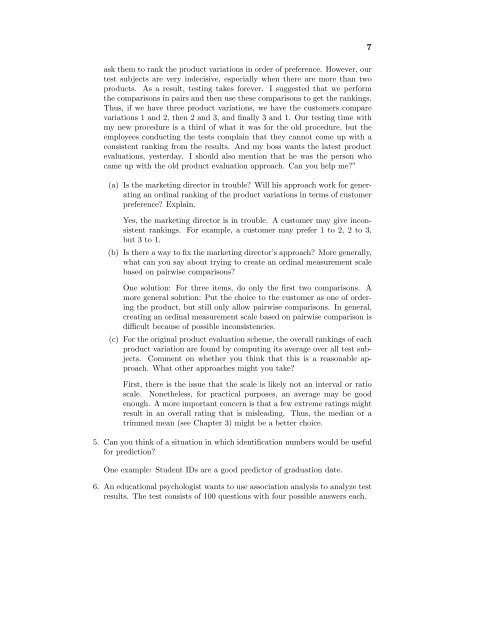Introduction To Data Mining Instructor's Solution Manual
Introduction To Data Mining Instructor's Solution Manual
Introduction To Data Mining Instructor's Solution Manual
Create successful ePaper yourself
Turn your PDF publications into a flip-book with our unique Google optimized e-Paper software.
ask them to rank the product variations in order of preference. However, our<br />
test subjects are very indecisive, especially when there are more than two<br />
products. As a result, testing takes forever. I suggested that we perform<br />
the comparisons in pairs and then use these comparisons to get the rankings.<br />
Thus, if we have three product variations, we have the customers compare<br />
variations 1 and 2, then 2 and 3, and finally 3 and 1. Our testing time with<br />
my new procedure is a third of what it was for the old procedure, but the<br />
employees conducting the tests complain that they cannot come up with a<br />
consistent ranking from the results. And my boss wants the latest product<br />
evaluations, yesterday. I should also mention that he was the person who<br />
came up with the old product evaluation approach. Can you help me?”<br />
(a) Is the marketing director in trouble? Will his approach work for generating<br />
an ordinal ranking of the product variations in terms of customer<br />
preference? Explain.<br />
Yes, the marketing director is in trouble. A customer may give inconsistent<br />
rankings. For example, a customer may prefer 1 to 2, 2 to 3,<br />
but 3 to 1.<br />
(b) Is there a way to fix the marketing director’s approach? More generally,<br />
what can you say about trying to create an ordinal measurement scale<br />
based on pairwise comparisons?<br />
One solution: For three items, do only the first two comparisons. A<br />
more general solution: Put the choice to the customer as one of ordering<br />
the product, but still only allow pairwise comparisons. In general,<br />
creating an ordinal measurement scale based on pairwise comparison is<br />
difficult because of possible inconsistencies.<br />
(c) For the original product evaluation scheme, the overall rankings of each<br />
product variation are found by computing its average over all test subjects.<br />
Comment on whether you think that this is a reasonable approach.<br />
What other approaches might you take?<br />
First, there is the issue that the scale is likely not an interval or ratio<br />
scale. Nonetheless, for practical purposes, an average may be good<br />
enough. A more important concern is that a few extreme ratings might<br />
result in an overall rating that is misleading. Thus, the median or a<br />
trimmed mean (see Chapter 3) might be a better choice.<br />
5. Can you think of a situation in which identification numbers would be useful<br />
for prediction?<br />
One example: Student IDs are a good predictor of graduation date.<br />
6. An educational psychologist wants to use association analysis to analyze test<br />
results. The test consists of 100 questions with four possible answers each.<br />
7


